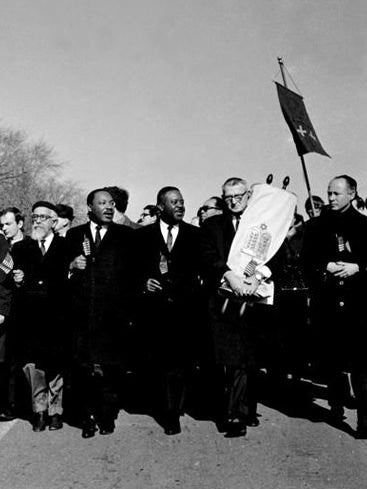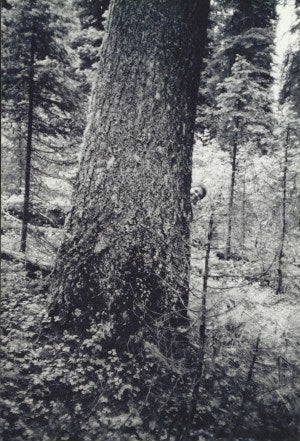My kids love superhero stories. These stories fill their imaginations about what they could do if they had great powers. I’m all for fantastical thinking, but I also want them to know that they don’t need superpowers to be the hero of their own story. I do this by teaching them about real people who’ve worked to make the world a better place. I start with our own family hero: my uncle, Rabbi Everett Gendler.

People find Uncle Everett captivating. He’s a slight man, with a gentle voice, and a small, mysterious indentation in his forehead. He listens more than he talks and makes people feel like they are the center of his world. After meeting my uncle, my husband said, “Paint him green, throw a burlap sack on him, and he’s basically Yoda.” I agree. Wise, he is.

Uncle Everett acts on his principles. In the 1950s, he became involved in the Civil Rights Movement. An early supporter and ally to this cause, he was instrumental in inspiring fellow rabbis, including Rabbi Heschel, to participate in prayer vigils and protests throughout the southeastern United States. In turn, he was arrested with Reverend King three times. His commitment to social justice and peace has permeated his work. He has written extensively on Jewish nonviolence, and he developed curriculum and teaches strategic nonviolence to Tibetans in exile living in India.
In addition to his social justice activism, Uncle Everett was the first environmentalist I ever met. He’s referred to as the “father of Jewish environmentalism,” cementing this title when he installed the world’s first solar eternal light in 1978. He’s written and spoken about vegetarianism, gardening, composting, the Earth’s natural rhythms and cycles, and how the local environment influences spiritual practice.

Uncle Everett is an activist in every sense of the word: he walks his talk. Over the years, he’s received accolades and awards. A foundation was started in his honor.
My husband and I tell our kids our own stories, too. We talk about my husband’s career, first as a firefighter and now as a surgeon, and how he helps people when it’s needed most. My kids love to hear about why I lived in the woods in Idaho after college. I wasn’t searching for enlightenment or attending a corporate retreat, I moved there as an environmental activist, working to stop logging in old growth forests. I’ve protested the Aryan Nation, rallied in support of dam breaching, and worked to promote indigenous rights. Currently, I teach English to a woman from Syria.

The actions to create change and their results can vary significantly. When Uncle Everett first marched with Reverend King, he did so because he thought it was the right thing to do. He wasn’t looking to be a hero; he was acting on his convictions and his moral compass led him to participate in activities that are now seen as extraordinary. It was hard; it challenged the social norms; he was arrested. History has shown that his illegal action was the correct one, and he’s honored today for his foresight. My personal examples haven’t landed me in jail, but they are steps to create change. I’m not Wonder Woman, and I don’t wear a cape, but my kids do see me write letters, publish articles, canvass, make calls, and attend community meetings. They see me cry, and they see me celebrate. To them, my actions are heroic, and I want them to think that. They should know that small actions matter, along with the big ones. I want them to understand that taking action is part of what makes me - me. It’s in my blood.
It would be easy to close our eyes and dream that we could have superpowers, but in reality creating change takes work and perseverance. The corn doesn’t grow by itself; it requires composting, hoeing the soil, planting the seed, and watering and caring for it. Similarly, heroes aren’t born, they’re made through conviction and stringing small actions together that create a story. Recently, I learned that Uncle Everett met Rosa Parks at the Highlander Folk School before she famously refused to sit at the back of the bus. I had always assumed that one day she simply got fed up and refused to move; I didn’t know that she was trained to become a movement leader. This reminds me of nonviolence trainings I attended in the woods in Idaho and warehouses in Seattle, of the training my aunt and uncle give to Tibetans in India, of my friends who are training future farmers, and of those who encourage kids to take action at their school to address issues such as water bottle waste.
So, I’m training my kids. We’ve taken our kids to two marches: the Women’s March and the March for Science. In preparation, we explained the history of marches and our right to peacefully protest. After the Women’s March, we looked at the pictures of millions of people around the world who participated in similar events. We told our kids that they were part of history; they were heroes. My daughter, thrilled to be part of something big and important, asked me, “Can we protest again tomorrow?”
We are all storytellers. Our stories are the individual threads that are woven together to create the fabric of our society. We need to work to make a difference, because it shouldn’t just be Greek Gods and comic book superheroes that we look to for inspiration. We need to teach our kids about the heroes who live all around us, because heroes don’t always wear capes or have Wikipedia pages. Heroes usually look just like the person staring back at you in the mirror.
